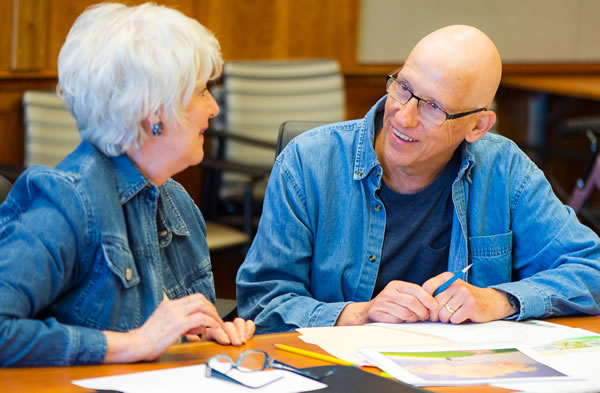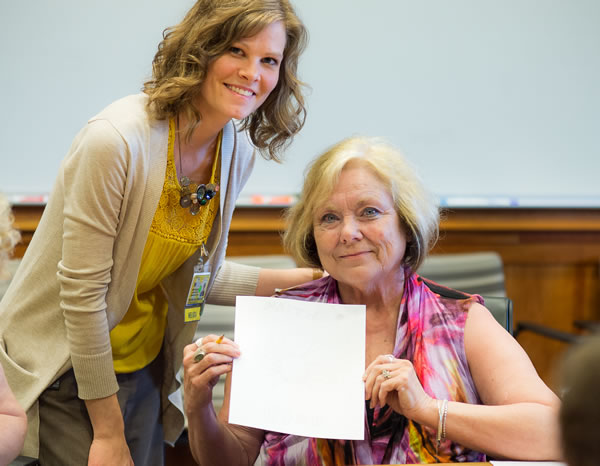Creativity is Calling
One patient shares his artistic abilities to cope with cancer

THE PICTURE CHANGES WITH A CANCER DIAGNOSIS
For 66-year-old Christian Rasmussen, to be human is to be creative. Despite changing his major in college from art to psychology, his artistic calling never left him. He ended up in the field of occupational therapy, a health discipline that involves teaching patients to find new and creative ways to perform daily tasks and adapt to disabilities.
He also took art classes every chance he got, developing an interest in drawing, painting and creating murals.
A series of stomach issues earlier this year led to a hospitalization. The doctors told him he had a golf ball-sized mass on his pancreas. initially thought to be a pancreatic cancer. Biopsy, however, diagnosed a diffuse large B-cell lymphoma. In his case, the malignant lymphocytes formed a tumor in his pancreas.
His treatment plan at the University of Michigan Rogel Cancer Center consisted of multi-agent infusional chemotherapy.
In the midst of adjusting and trying to maintain a positive attitude, he heard about an art therapy workshop at the Cancer Center. His creative calling beckoned. He signed up to attend.
CREATIVITY AS A WAY TO COPE
In 2016, the Rogel Cancer Center offered art therapy workshops at no cost to patients and a loved one. The workshop Rasmussen attended was a group workshop with a specific project goal: to develop a page to be included in a coloring book for cancer patients.

"The emotions involved in coping with treatment, living with uncertainty and meeting the challenges of everyday life are often hard to describe in words," says Art Therapist Melinda Hallenbeck-Kostecky. "Making art that is meaningful to you can provide support that is nontraditional, creative and unique to your personal journey."
Coloring books have become a popular resource for stress relief. Hallenbeck-Kostecky felt it was important that a coloring book for the Rogel Cancer Center be designed by and for the community.
Art therapy in health care is a proven complementary therapy to cancer treatment and offers many benefits, including:
- Decreasing stress, depression, anxiety and feelings of isolation
- Increasing relaxation, self-awareness and self-esteem
- Enhancing coping skills, resilience and quality of life
Rasmussen experienced several side effects from chemotherapy and much of his care involved recovering from the drugs. He relates the unpredictable experience to that of another cancer survivor, Kathleen Galligan, who described it like "a joyride with a drunken driver."
Rasmussen is an experienced artist compared to most workshop participants. He ended up seated next to a patient, Elaine Jacobs, who wanted to create a coloring book page, but had no artistic background.
"I was able to engage with the woman next to me because I used to draw caricatures. We drew a caricature of the cancer experience, coming up with all the ingredients of a cancer stew. It started out pretty dark, but we added different ingredients to make a healthy cancer stew in a big pot," he says.
Rasmussen also created his own coloring book page, which reflects his passion for art and the changing of the seasons. His page includes a tree for each season throughout the year.
"To everything, including cancer, there is a change and purpose," he says.
Workshop participants continued to meet at the Cancer Center over several months to work on their pages. They also worked at home. The final pages will be compiled into a book that will be given to patients as a way to relieve stress.
MORE THAN ART: THE HEALING ASPECT
Art therapy includes more than making art. Hallenbeck-Kostecky, in addition to being a skilled artist, is trained in mental health counseling and directs workshops with healing in mind. After introductions and some group discussion, many participants continued individual discussions while making art, some sharing cancer stories and others enjoying conversations about other topics.
Rasmussen completed treatment late last summer, needing to extend his medical leave of absence to regain his strength. He returned to work after Labor Day and the two coloring book pages were keeping him busy. Hallenbeck-Kostecky will compile and produce the final book.
Watch a video of Christian Rasmussen working on another art therapy project.
Continue reading the Fall, 2016 issue of Thrive.
NOTE: Although the Rogel Cancer Center isn't offering art therapy workshops, patients and their families can schedule one-on-one sessions with our art therapists by calling 734-232-6366.
Learn more about art therapy and all of the support services available at the U-M Rogel Cancer Center:
updated 2.21.2022
